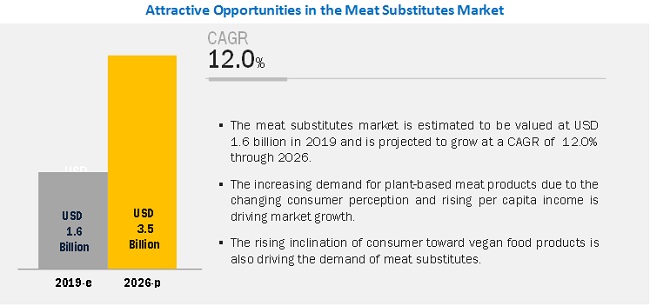The meat substitutes market is projected to reach USD 3.5 billion by 2026, from USD 1.6 billion in 2019, recording a CAGR of 12.0% during the forecast period. The rising awareness about plant-based meat and increasing health-cautiousness due to increasing obesity are projected to drive industry growth during the forecast period.
The tofu product segment is estimated to dominate the meat substitutes market due to the increasing acceptance of them among plant-based meat manufacturers
Tofu has been traditionally considered a meat substitute in many countries. This is due to its low cost and easy availability. Tofu also resembles the taste of meat and helps to replace pork, chicken, and beef products. Moreover, it also has a high nutritious value, the rising awareness about which is also propelling the market. In a few clinical studies, tofu is proved to provide protection against cancer, heart diseases, and also helps in lowering the levels of bad cholesterol or low-density lipoprotein. Thus, these factors are dominating the tofu segment globally.

Download PDF brochure: https://www.marketsandmarkets.com/pdfdownloadNew.asp?id=979
The demand for pea protein, as a source, to remain high during the forecast period
The market for pea proteins as a source of meat substitutes projected to grow at the highest CAGR during the forecast period; the projected growth is owing to the high nutritious value that pea protein. Furthermore, the rise in disposable income among the increasing middle-class population of Europe is facilitating more expenditure on the premium, highly-priced, and pant-based meat products. Hence, the growing demand for vegan products in the region is expected to fuel the growth of pea protein meat substitutes.
The solid segment is estimated to dominate the meat substitutes market due to the increasing consumption by food manufacturers
The solid segment, by form, is projected to dominate the global meat substitutes market during the forecast period. This is due to the high consumption of solid meat substitutes in powder and chunks forms. Solid meat substitutes also help to increase the shelf-life of products, which help food manufacturers to buy solid meat substitutes at a wholesale level, which reduces the cost of raw materials. These factors have been driving the growth of this segment for the past few years.
Asia Pacific is projected to witness the highest growth in the meat substitutes market during the forecast period
Asia Pacific’s growth is attributed to the increasing awareness of people about healthy dietary habits. The key factors driving growth in the Asia Pacific region are the need for health benefits, animal welfare, environment safety, cost affordability, and the growing variety of plant-based meat products. The awareness created through global animal welfare organizations, such as PETA (People for the Ethical Treatment for Animals), has led to people considering a meat-free diet. Non-meat-based meals are already popular in Asia, with tofu used extensively in Asian cuisines and bean-based congees widely consumed in countries such as China. Moreover, the increase in the number of start-ups in Asian countries such as India, Japan, and China is also further propelling market growth.
Request for Sample Report Pages: https://www.marketsandmarkets.com/requestsampleNew.asp?id=979
Key Market Players:
Many domestic and global players provide meat substitutes of various types across the world. Major manufacturers have their presence in the North American and European countries. The key companies in the market are Archer Daniels Midland Company (US), DuPont (US), Roquette Frères (France), Kerry (Ireland), Ingredion (US), Sotexpro S.A (France), CRESPEL & DEITERS (Germany), CHS INC. (US), Suedzucker (Germany), MGP Ingredient (US), Puris (US), The Emsland Group (Germany), and Cargill (US).